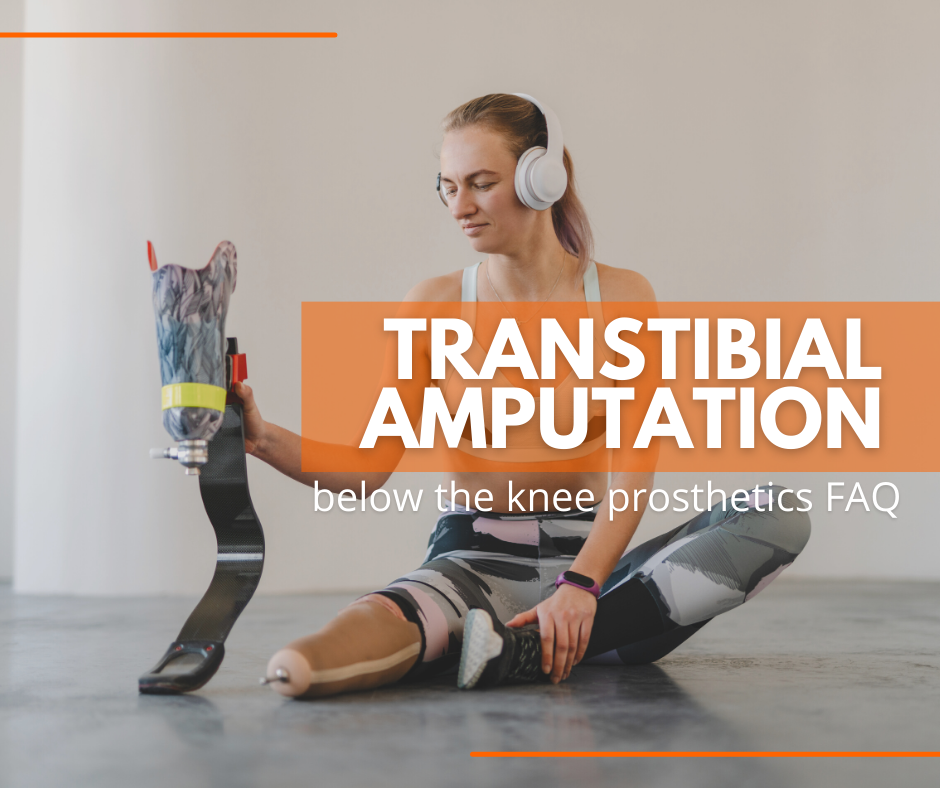
Transtibial Amputation Prosthetics FAQ

What Is Transtibial Amputation?
If you are not familiar with medical lingo, transtibial amputation refers to the amputation of the parts of the leg that are located below the knee. This is typically only done in severe situations of damage to the area or of disease. Some of the reasons why someone would consider undergoing this could be because of diabetes, foot ulcers, or trauma to the area of the limb.
Most are performed because of peripheral vascular disease, which is a disease of the lower limb. The leg cannot heal if there is poor circulation, and this may cause it to ulcer and become infected beyond the point of medication. This is a life-threatening situation that can cost you dearly. And so, to save your life, the bones, muscles, nerves, tendons, and everything else are removed from the patient’s body to ensure a longer lifespan.
This type of amputation is performed by either a vascular or orthopedic surgeon who will remove the limb and then reshape the remaining limb to allow for the use of a prosthetic leg once they have recovered.
The Process and Physical Therapy
This surgery is often thought to be done as a last-minute decision in which you don't have time to think before it must be done. The truth is that the scenario only happens in extreme situations in which leaving the infected limb attached for any length of time risks death.
Typically, you will have time to consider this very important alteration to your life and prepare for it. Physical therapists can be brought in to help prepare for how things will be different. Before surgery, they will help you by working on conditioning your body to help compensate for the loss of the limb by improving the strength in your hip and knee. They will also work with you on learning how to walk with a walker or crutches and educating you on what to prepare for when the procedure is over with.
After the surgery and the recovery time at the hospital, the physical therapist will work with you on rehabilitation and help to prevent any complications that may arise after surgery.
The Prosthetics Process
To help with the loss of an important limb, people can get prosthetics to replace it. This is a tool that can help improve a person's lifestyle and give you some semblance of normalcy. To get one, the area where the prosthetic will be attached must be mapped out to ensure comfort.
Modern companies that specialize in this will use digital imagery to help ensure that the prosthetic is a perfect fit. Once it is made, the unit will be attached and altered to make sure that it is comfortable. The crafters will go over any maintenance that needs to be done and ensure you can understand the limits of this extension of the body. This can seem overwhelming, but companies like AOD Prosthetics and Orthotics will offer resources and in-person guides to ensure that you are fully prepared for this big change.
The Cost of Prosthesis
The price of a prosthetic limb can cost anywhere from $5,000 to $70,000, and the life span of each prosthesis is only three to five years. This can make it expensive, but some resources can help. Some organizations will cover either the entire cost of the prosthetic or the majority of the cost with minimal expense. Finally, if you are a soldier, military insurance and veterans programs will help fund the cost of your prosthetic.
Things to Be Aware Of
Most people don’t know of the issues that arise when adding a prosthetic to their life. Though some of them can be troublesome, none of them are truly life-altering so long as you take the time to learn how to best counteract them.
One is called hyperhidrosis, which is excess sweating when the body is struggling to regulate its temperature.
Another is the changing of the limb shape as the body settles into the new prosthetic. Because the area of the knee that remains is rubbing and pressing down on the prosthetic, it can cause it to change forms, and that may mean you need either padding or possible replacement.
The next is weakness in the limb. This can make using the prosthetic troublesome for any length of time.
Finally, there is phantom limb pain that can make using prosthetics troublesome.
Pros of Prosthetics
Though there might be issues that come along with having one, a transstadial amputation prosthetic limb will improve your life. It will make walking easier. Plus, it will take away the need for crutches and replace them with a socially acceptable cane. Sitting and standing will become easier as you'll have the support you need to do so stably. Also, the prosthesis can make you more comfortable, both physically and emotionally. A good prosthesis can help you feel as though you are physically complete. It can greatly improve your quality of life and help keep you from feeling socially ostracized.
For more information about prosthetics, reach out to us at AOD Prosthetics and Orthotics.
Quick Overview
- What Is Transtibial Amputation?
transtibial amputation refers to the amputation of the parts of the leg that are located below the knee. This is typically only done in severe situations of damage to the area or of disease. Some of the reasons why someone would consider undergoing this could be because of diabetes, foot ulcers, or trauma to the area of the limb.
- Who Performs Transtibial Amputations?
This type of amputation is performed by either a vascular or orthopedic surgeon who will remove the limb and then reshape the remaining limb to allow for the use of a prosthetic leg once they have recovered.
- When Should I Get Physical Therapy for a Transtibial Amputation?
Typically, you will have time to consider this very important alteration to your life and prepare for it. Physical therapists can be brought in to help prepare for how things will be different. Before surgery, they will help you by working on conditioning your body to help compensate for the loss of the limb by improving the strength in your hip and knee. They will also work with you on learning how to walk with a walker or crutches and educating you on what to prepare for when the procedure is over with.
After the surgery and the recovery time at the hospital, the physical therapist will work with you on rehabilitation and help to prevent any complications that may arise after surgery.
- What is the Cost of a Below the Knee Prosthetic?
The price of a prosthetic limb can cost anywhere from $5,000 to $70,000, and the life span of each prosthesis is only three to five years. This can make it expensive, but some resources can help. Some organizations will cover either the entire cost of the prosthetic or the majority of the cost with minimal expense. Finally, if you are a soldier, military insurance and veterans programs will help fund the cost of your prosthetic.
- What are the Benefits of a Transtibial Amputation Prosthetic Limb?
Though there might be issues that come along with having one, a transtibial amputation prosthetic limb will improve your life. It will make walking easier. Plus, it will take away the need for crutches and replace them with a socially acceptable cane. Sitting and standing will become easier as you'll have the support you need to do so stably. Also, the prosthesis can make you more comfortable, both physically and emotionally. A good prosthesis can help you feel as though you are physically complete.
Treatment & Planning for Tomorrow
AOD Prosthetics & Orthotics combines the highest technology available with the best patient care. Bilingual mobile prosthetic service in San Antonio. Serving amputees and improving their quality of life.

All Rights Reserved | AOD Prosthetics & Orthotics | San Antonio, TX


